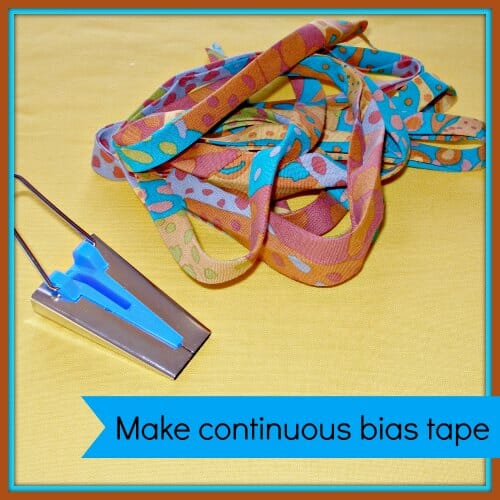
I was so inspired by some of the projects shared as part of the Seasonal Sewing Series back last November that I have been keen to try my hand at lots of non-clothing sewing projects. On my list for this month – sewing for the kitchen and I wanted to make some swanky potholders. Oh no, they need bias binding, and I've never made or even used it before. So here's my first attempt at making continuous bias binding tape – shared for you all to enjoy or laugh at, depending on how it turns out!
Materials
You will need:
- A square of cotton fabric
- A ruler and Fabric Marker
- Scissors
- An iron
- Optional but highly recommended – a Clover Bias Tape Maker
Two ways to make bias binding
It seems there are two main ways to make bias binding strips.
- Cut lots of individual strips of fabric on the bias. Discard all the edge pieces which are too short. Sew the lot together individually to make one long strip. (Nah, sounds like too much little fiddly stuff.)
- Turn a large square of fabric into one long strip and avoid the fiddly stuff with very little waste. (Sounds like my favorite option.)
If you want to have a go at option 1, then you will find some really good tutorials on the So Sew Easy Sewing Tutorials Group Board. Not a member yet ? – you should be! It's the best place to pin all of your favorite sewing tutorials and find new ones. Read about it here and let me know if you want to join.
Making Continuous Bias Binding Tape
We need to start with a square of fabric. Make sure to cut it accurately. Later on, I'll be sharing a table and a spreadsheet calculator which will show how much you can make from a square of any size, or how big a square you need for any length. For now, I'm using an 11 inch square of cotton.
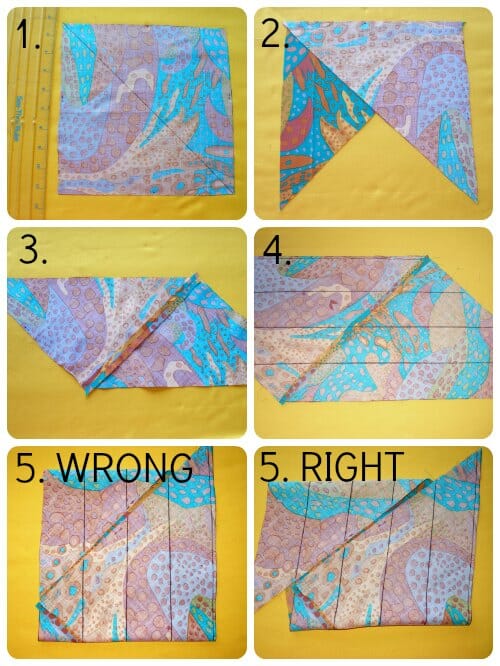

1. Mark with your fabric marker just some little dots on the wrong side on opposite edges, 1 dot on two sides and 2 dots on the other sides. This will help us line up the right edges later on. Draw a line across the diagonal from one corner to the other then cut along this line to make two triangles.
2. Place the triangles right sides together, matching up the sides with the single dot. Sew with a 1/4 inch seam.
3. Open out and press the seam flat. You now have a funny shape called a parallelogram.
4. Starting at one of the long edges, draw lines right across the fabric. I want to make double fold 1/2 inch finished tape so I am cutting my lines 2 inches wide. 2 inches folded in half twice = 1/2 inch. You'll probably end up with some extra fabric at the top that doesn't make a full row. That's OK.
5. Now comes the tricky part. It's time to sew the sides together that have the two dots we marked earlier. BUT – they don't go together evenly. If you sew them together evenly you'll end up with rings of fabric, not one long strip. So you need to OFFSET the rows by one.
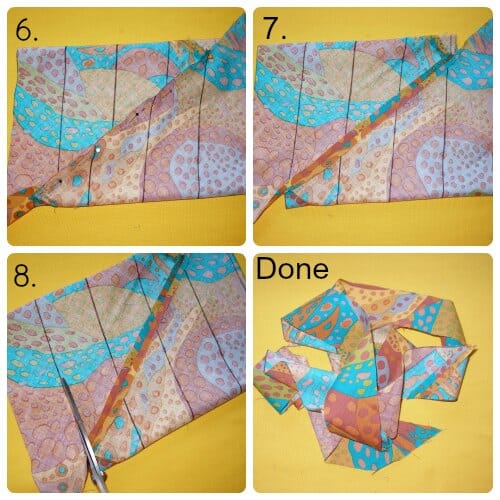

6. We are going to sew with a 1/4 inch seam again, so to line up accurately, I stuck a pin through the FIRST line at 1/4 inch from the raw edge. Then I stuck the same pin through the SECOND line on the other edge of the fabric, 1/4 inch in from the raw edge. Once these were matched, I could pin all the way along.
7. It's going to look rather odd, with a spare bit of fabric hanging off either end, but it's all going to work out well in the end so stick with it. Sew these two edges together with a 1/4 inch seam, then press this seam open.
8. Now it's time to cut. Start at one edge and cut along the line you drew earlier. As you continue to cut, you'll see that you don't come to the edge of the fabric, you just keep on and on cutting in one long spiral, until eventually you get right to the other side of the fabric and have cut a big long strip 2 inches wide. Magic, and no fiddly sewing of little bits together.
Turning the strip into bias tape
There are basically two methods for turning your long strip of fabric into usable bias tape:
- Fold it all very slowly and meticulously by hand as you iron. (Boring, with burnt fingers)
- Spend a few dollars on a handy bias tape making tool and actually have fun doing it in super quick time. (Guess which one I went with!)
If you don't have a bias tape maker, then the procedure would be to fold your fabric in half all the way along and press. Then open out, fold in the edges towards the center, fold in half and press again. Laborious if you have a lot of length, but it can be done with good results.
With the Swanky Clover Bias Tape Maker, it's actually fun and really fast. I bought the 1 inch size – careful when you buy the tape maker because the sizes can be rather confusing. The 1 inch size takes 2 inch wide strips and makes 1/2 inch wide double fold tape. Confusing right?
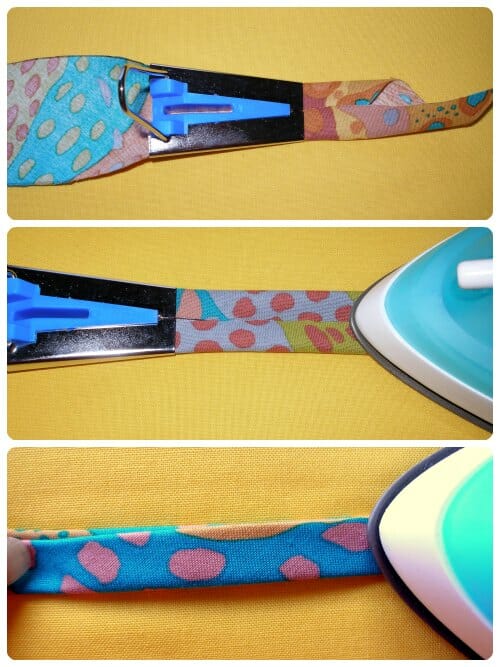

Simply take one end of your tape and feed it wrong side facing up into the wide end. I used a pin to help feed it through to get it started. Then you can pin the end to your ironing board, gently pull the little handle and press with your iron when the neatly folded tape comes out the end. Eventually I got fed up with repositioning the pin, and I just pushed the maker along the ironing board with the tip of my iron slowly and this worked just fine too.
Once you have the neatly folded tape, now you can fold in half again and press to make the double folded tape. Traditional bias binding is usually a fraction wider on one side than the other, so you can make yours this way too by folding the top over so it doesn't quite meet the edge on the bottom. And voila! Your own cute home made bias binding.
Wrap it up neatly on a piece of thick cardboard and pin in place and it will be ready to use. I've got so many ideas for how I might use this tape and I went a bit crazy and made yards and yards all in different fabrics. It was really quite fun.
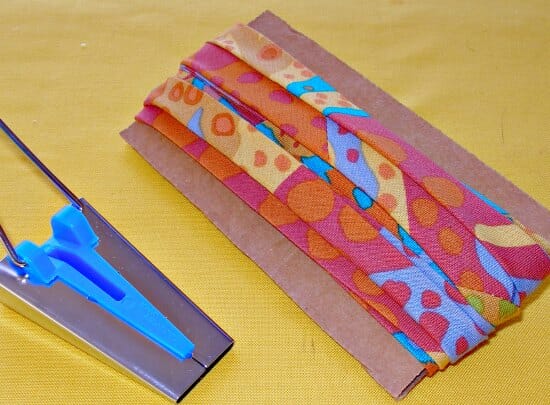

Have you ever made your own continuous bias binding? What do you use it for? Share a link to your projects in the comments…









Hi Mayra I just found your post as I was suffering the net and tried to follow your instructions. I can get as far as the 4th picture but get ost after that do you have a video of how it is done 🙁
Mayra, so this post a year or so back. In the meantime, CoVid. I made bias tape our of quilting scraps to use when I ran out of elastic. I just pieced a 12 inch square and then followed as per your method. It was tricky to get the many seams through, but they were such a hit! Strange mixes of priates and spaceships and polkadots and unicorns all dancing on ties for face masks. Brought a smile to everyone who saw them. I have decided on a similar style to finish the edge on a couple of summer shirts…just for the fun of it!
🙂 I can imagine, very happy you are happy!
Over 50 years I have used a variety of binding methods including with Bias, and I agree in most cases you need a binding material a little finer than the fabric type you are binding, and prepping continuous bias in non stretch for non stretch fabric is no problem as per Mayra’s instructions above in this post.
However my favourite method by far in to use lightweight minimal stretch (fabric with “give”)such as Tricot, Linnel, Stretch Satins, Fine Ponte/crimpelene, Stretch Poly Cottons – you are seeking something with a 15-20% stretch n the drop (too stretchy= too sloppy and won’t do the job) will do or Mechanical Stretch Suiting fabrics (the give is in the weave- diagonal to diagonal, hence the word mechanical)- this fabric looks like lightweight gabardine for summer suits/corporate wear – favourite all time fabric (can’t kill it!!) Has minimal Poly fibres in the weave keeping it soft, breathable and drapes beautifully, but has enough body and give to be super comfy for long pants, Jackets, skirts, I have suits made 20 years ago that still look new. So it’s very hard wearing with no pilling.
Cut in most cases along the selvedge (the minimal stretch following the length of the fabric). The greatest stretch 15-20% only – is in the drop (the width) .
So there is no need to use a bias tape tool, or to iron as the fabric once cut either side of the strip will curl inwards toward each other – ready to be pinned and sewn. Does not “crease” so can make a ton of it and roll in a ball if you like or wrap around cardboard foil rolls.
I usually do at least a metre, at a time and the majority of these fabrics are at least 150cm W – so you are roller cutting through several thicknesses at a time – first – fold the fabric in half from the drop back to the selvedge = 1m along selvedge x 75cm W, then pin or clip to your cutting mat, and remove the selvedge edges, and then fold in half again back up to selvedge = 1m along selvedge x approx 35.5cm W ( 4 thicknesses to roller cut through).
Rule & Mark straight across ,strip widths suited to the project – in the direction of the Selvedge,1m across simply horizontal lines with curved end 1 side and then the opposite side in the next line down and repeat til the end,, essentially you are cutting out a continuous snake shape, try to find a curved object to trace lines around from side to side that matches the width of your strip like a plastic bottle top etc..
So no waste no stitching pieces together, once cut just pull to stretch the fabric strip in order for it to curl – the Mechanical Stretch Suiting will not curl the same as the Tricot, Linnel and retain it , but it has the give to stretch around curves and great for a cotton /linen/ furnishing fabric binding comes in a huge range of plain colours as well as some prints. HOPE THAT MAKES SENSE
[…] strips of fabric together. So Sew Easy has a tutorial showing how make continuous bias tape. Go to her post to see how to do it, and also to see how her first attempt at making continuous bias tape turned […]
Actually, Mayra, your favorite way to make bias tape is my favorite way, also! I usually make my own when making purses, totes, placemats, home decor projects, etc. I like it much better than purchasing the bias tape. Thank you for your great instructions on how to do it!
The very BEST explaination of making continuous bias tape I have seen to date! Thank you for the great photos and details.
Excellent, thank you.
I have seen this method before but the instructions were difficult to follow but made it through Your photos and instructions are clear and easy.
Some gals may not know but most store bought tape is part or all polyester and should not be used on potholders or anything that comes near a heat source. That is why I started making my own but became so fun I began making it for a lot more of my items.
The little implement makes it a breeze!
THANK YOU FOR YOUR TIME IN MAKING GREAT INFORMATION FOR US!
Genius! I’ve struggle with making seam bindings for many years, always preferring to buy it ready-made. But this will make my garments wayyyy more professional. Thank you!
This is so interesting and informative. I’ve been making quilts just 2 years. For binding, the pattern always has you cut 2.5” strips of fabric, sew them together, iron in half, then attach to bind quilt. I am VERY interested in getting a bias tape maker but wondering… why do the parallelogram strips (on bias)? Can you just cut straight WOF lengths and feed those in the bias tape maker to save time? Does that not work? Sorry if that’s a dumb question. 🙂 Thank you!
The resulting product would not be bias tape. It would be straight grain folded tape. The advantage to cutting on the bias is that it stretches and allows binding smoothly around curves.
You don’t need bias cut binding for a quilt because you are generally sewing it in a straight line. The bias cut allows stretch for easing around curves.
As she explains at the beginning, you can cut multiple strips and then sew them together after you cut the strips, but when making bias tape, you must make sure to cut the fabric on the bias, not with or against the grain, hence the parallelogram.
If you want fewer seams in your binding strip and if you have enough fabric, you can draft a large parallelogram from the beginning, instead of a making a square that has to be cut and seamed to create a parallelogram. This will give you longer sections without seams, a benefit when finishing and attaching the binding. You can draw the strip widths and finish the same way. The 45° slant of the sides of the parallelogram will match the bias of the fabric.
A tip to help with minimizing bulk in the folded binding is to cut the strips slightly smaller than 4x the desired finished binding width. For example, to get 1/2″ binding, make 1-3/4″ strips. When the strip is folded in from the sides (either manually or with the binding maker tool), the sides don’t quite meet at the center. This slight gap allows ease for the turn of the fabric over the thickness of the binding seams and what the binding is encasing, reducing the finished bulk and making the sewing easier.
How do you draft a parallelogram on a rectangle?
ABSOLUTE GENIUS
I have never seen this technique for making bias binding before. It’s so simple – such clear instructions ?? We have been in lockdown for 4 weeks so I decided to make my granddaughters aprons from a pillowcase – and used this technique for the bias binding. Very happy Would like to add a picture but cannot see where to do it
Hi Sharon I took out the ability to add pictures because it was costing too much money, you can use #soseweasy or #soseweasyofficial on Instagram or twitter, Facebook and all the people who follow so sew easy will be able to see it.
I have never seen this technique for making bias binding before. It’s so simple – such clear instructions ?? We have been in lockdown for 4 weeks so I decided to make my granddaughters aprons from a pillowcase – and used this technique for the bias binding. Very happy
My girl is doing Rock n Roll. Who is going to make her dresses (& boleros)? You bet. To hem a full circular skirt can be a tricky task so I made my own bias tapes (definitely the continuous ones) to finish the hem. ?
Love to see a picture, got an Instagram account?
Old silk ties make fabulous bias tape. Already cut on the cross. Just upick & press open & cur into your long strips & join. Run through you bias tape maker & there you have it. Always use bias tape made of thinner fabric than your project. I often keep scraps of cotton fabric to use inside jeans & trousers on the waistbands. Silk is great inside unlined jackets & fine dresses & blouses. You can have real fun with colour too. Lovely for a flash of hem on a skirt.
[…] How to make continuous bias binding […]
Just saw your post for continuous bias binding. I have been making bias bindings this way for many years. It’s great on the baby swaddles I make for our local Christian pregnancy center clients. Since I make several of these at a time, I make a large amount of binding and wrap the extra around paper towel cardboard, secured with a straight pin.
Thank you for all your work to help us “home sewers”.
[…] Making continuous bias binding tape […]
hi I have the four different colours of the binding makers but am confused by the width of the strips should be ive used the biggest one and they work great
I am waiting for my seam binding maker and really looking forward to making my own bindings. Generally I’ve only made straight fold, Not understanding the difference between bias and straight fold, but this explanation on how and why was great. Thank you so much.
Where is info to calculate how much a certain size square will make of bias binding?
Just looked at this tutorial again and saw your question. Under “tutorials” button for sewing tutorials, the link for the calculator is next to how to make bias tape. The title is “Continuous Binding Calculator”
I need to bind a handbag I am making. The bag is made of backed curtain fabric, which drapes beautifully fir bags. I want to make the binding out of the same fabric, will your method work on a thicker fabric like mine?
HI Ruth, it will work however you will need to use an industrial sewing machine or a machine that can handle all the layers. I suggest you try on a scrap of fabric first.
I make biastape with large rectangles, and cut with a serger. Do you measure the lines from the bias cut, or the st grain edge? I always have a problem with that, but it can make up to 20m of biastape at a time, so am loath to go back to a square of fabric.
Hi Ethal, i think doing what works for you is the way. If I need a lot of bias tape I use the method mentioned in this article, but if I want bias tape that is perfect I fold the fabric into a triangle using the selvage as a guide then draw the line then i cut using a ruler and a rotary cutter.
I have been tempted so many times to buy a bias binding maker but I wasn’t sure how well it would work so I always chickened out and bought the pre-made stuff. Now I think I’ll go out and get one. Thanks for posting this!
This is a brilliant tutorial, but my tape wasn’t great. I used linen/cotton mix to match garment; and I think maybe it was too thick. In places the two seams almost abutted each other and I couldn’t get it to go through the Clover thingy neatly. I tried again using test strips 1 1/4 in wide in the same Clover thingy and this seemed to work better. Hopefully, it will work better on the next project.
This is just what I need. Good timing! Thank you so much. Cheryl p.s. In your wealth of knowledge do you have any hints and tips on how to make a knit bias strip to put on the neckline of knit top, including hatchi sweater knits, ity knits, cotton knits, etc. I never dreamed there were so many. And I’ll bet there is a different way to do it for a lot of them. Is there a basic way to do it and then just get it to fit without all those wrinkles that I have seen on so many necklines? Any assistance you have to offer would be very much appreciated.
Hi Cheryl, always great to hear from you. The trick with bias strip in a collar is to cut it a little bit smaller than the neckline, depending on how much stretch is there, 1/2 to 1″ is enough to avoid the wrinkles. You will have to stretch the strip. I do this technic here https://so-sew-easy.com/high-low-t-shirt-hide-panty-line/